
|   |

|   |
 e-mail: leelakaverivenkat@gmail.com Impressive Sattriya dance drama captures life of Sankaradeva Photos courtesy: JNU November 5, 2018 It was by all accounts an impressive curtain raiser for Satraranga's collaboration with JNU; the latter unfortunately of late have been in the news for the wrong reasons. Developed as part of a Production Oriented Workshop for the Sattriya training classes held in the University, the choice of a dance drama on the life of the founder of Sattriya, viz. the religious teacher who compounded in his person the talents of artist, poet and dramatist, was very intelligent, for it provided scope for all levels of proficiency, enabling both novices and trained dancers to come together. Concept, Script and Direction for 'Dhanya Toho Srimanta Sankara' were by Dr. Bhabananda Barbayan with Niranjan Saikia Bayan working as assistant Director, and Rupashree Mahapatra, Gargi Goswami, Kiran Borah and Sukanya Boruah as the dance teachers. The manner in which the choreography was designed had to be lauded, for while enabling trained dancers to present their expertise in traditional group segments like Gayan, Bayan, Ojha, through experts from Uttar Kamalabari Sattra in Majuli, the narrative seamlessly wove in movement sequences by less experienced amateurs, without diluting the aesthetic totality. Roping in a trained NSD artist for set and light designing was a master stroke for while narrating the story of different areas in Sankaradeva's peripatetic life, minimal sets created the ambience. Right at the start following the prayer and homage to Sankaradeva, the opening scene was most suggestively communicated heralding the birth of a child in about 1449 A.D. in the home of a Devi worshipper Candivara. With the first cry of the child, the image of Devi beside him (along with the snake ) suddenly falls off its pedestal on to the floor - suggesting that a neo- Vaishnavite revolting against Sakta and Devi worship, had arrived in this world. The mother now comes out from the hut nearby with the newly born baby. Another excellent choice of guest artist was Kathak dancer Hemanta Kumar Kalita, who sustained the entire effort playing the lead role of Sankaradeva (mostly acting with minimal dance) with rare sensitivity, his ability to get into the skin of the role creditable. The cardinal points of Sankaradeva's life were very well captured. The child growing up, his revulsion for animal sacrifices, his inclusive nature with no caste preferences are all briefly captured. The scene of the maiden Sankaradeva drama CihnaYatra, staged for a period of seven days in 1468 (according to what is written) with the Sapta Vaikuntha (seven supreme abodes of Lord Vishnu) suggested in a painting on a cloth - and this scroll according to records was painted by Sankaradeva himself and he was the dramatist, musicians, actor rolled in one in this presentation. This is followed by a brief riveting sequence of Dhemali with Gayan / Bayan with the Kohl players from Uttar Kamalabari Sattra (the cymbals are heard in the sound track but not shown through players in the dance). Slide show Photos courtesy: JNU 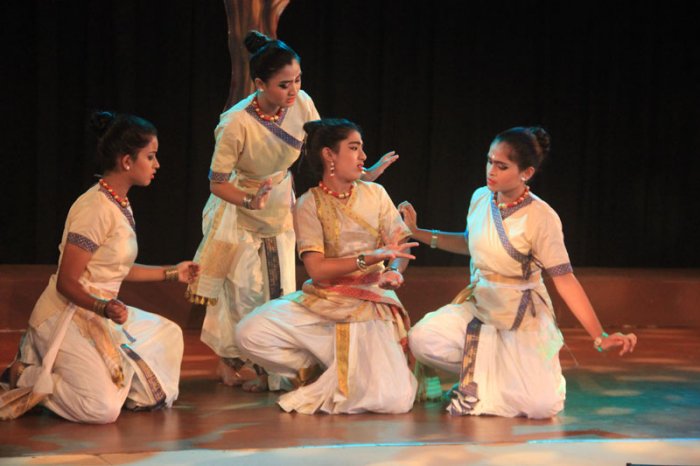
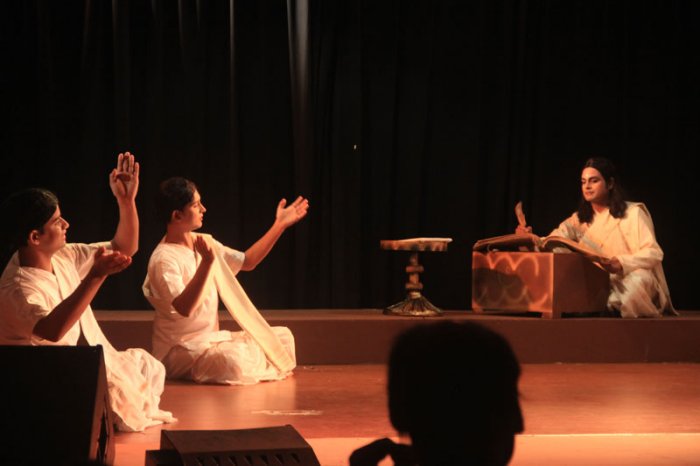
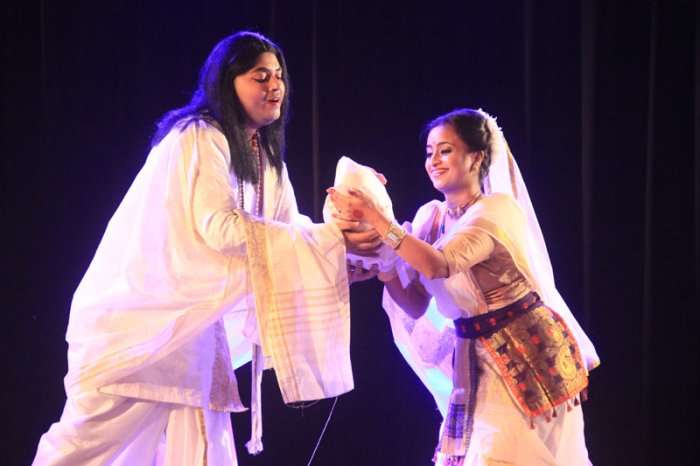
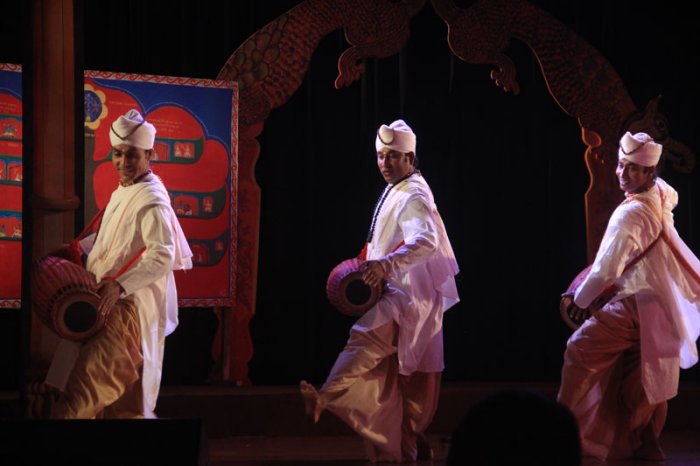
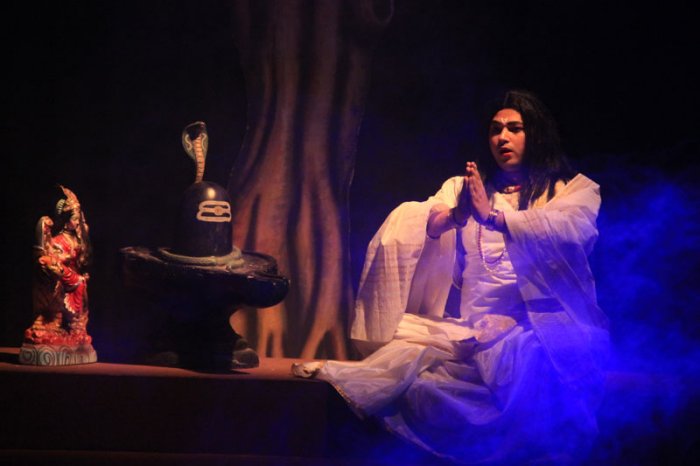
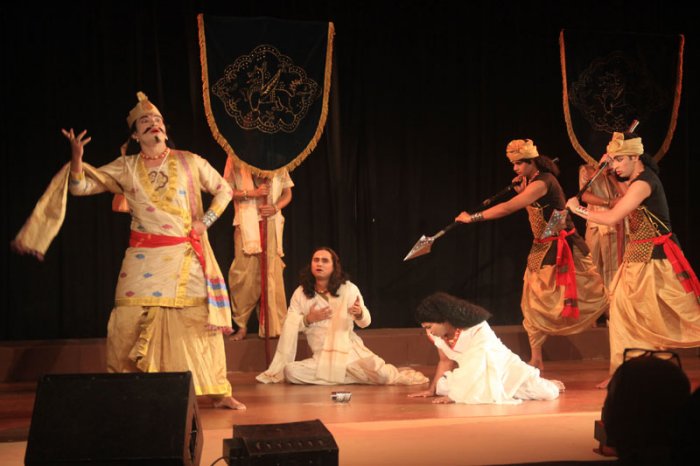
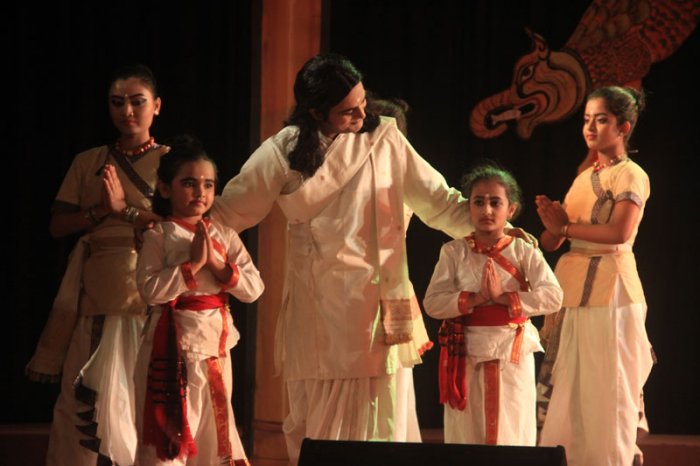
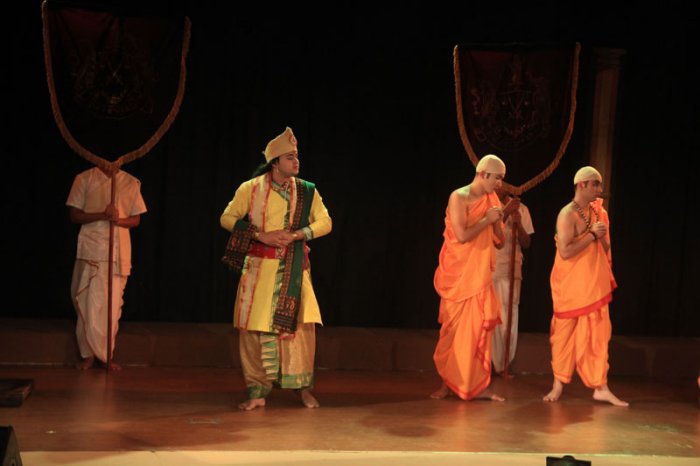
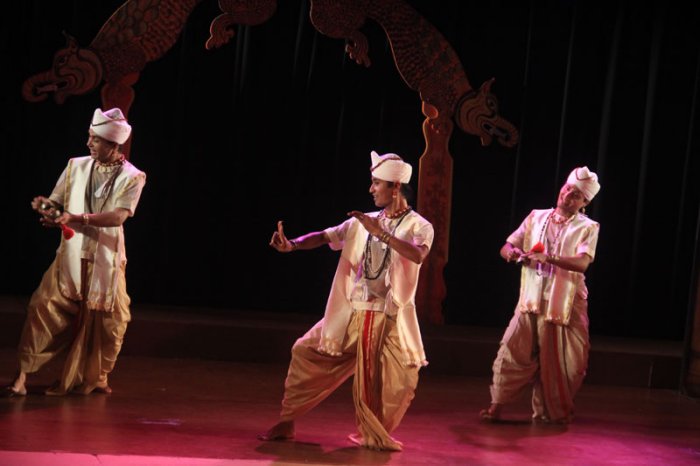
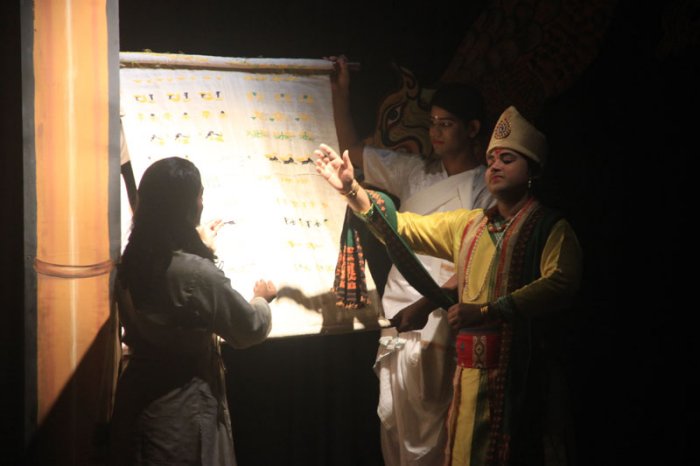
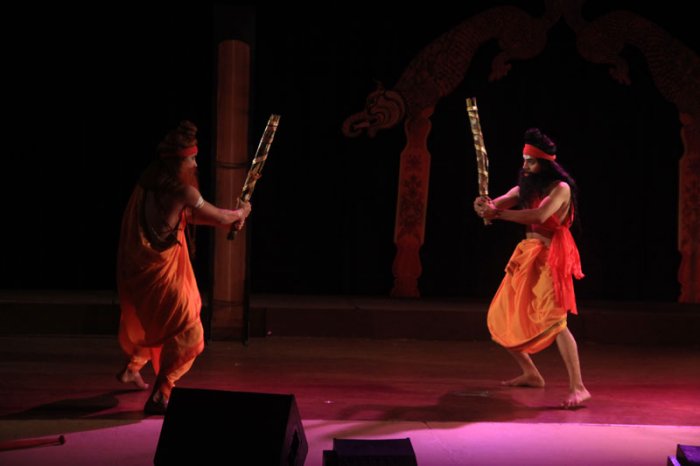
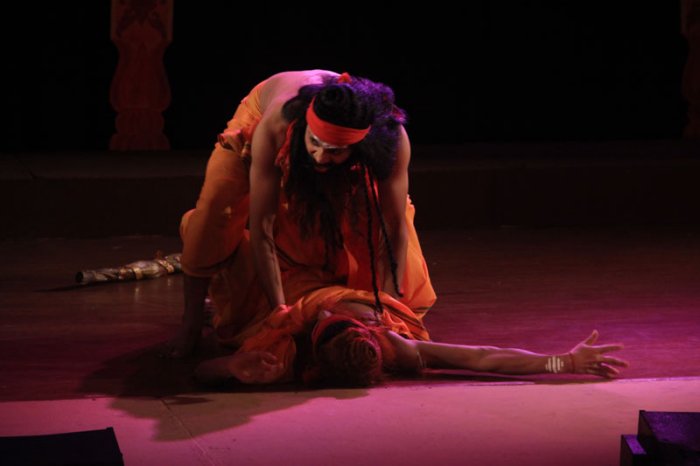
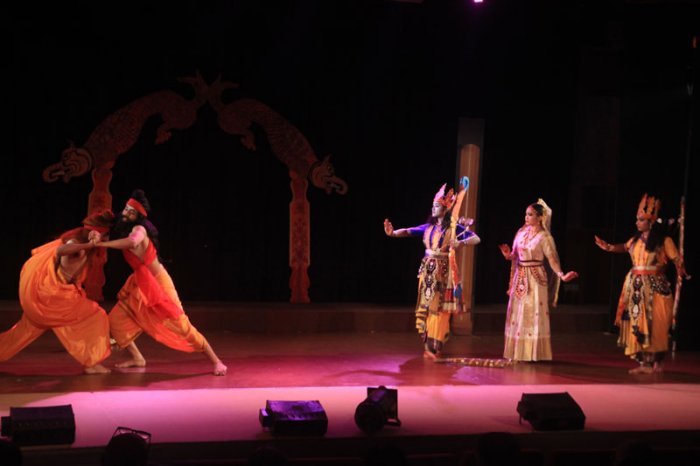
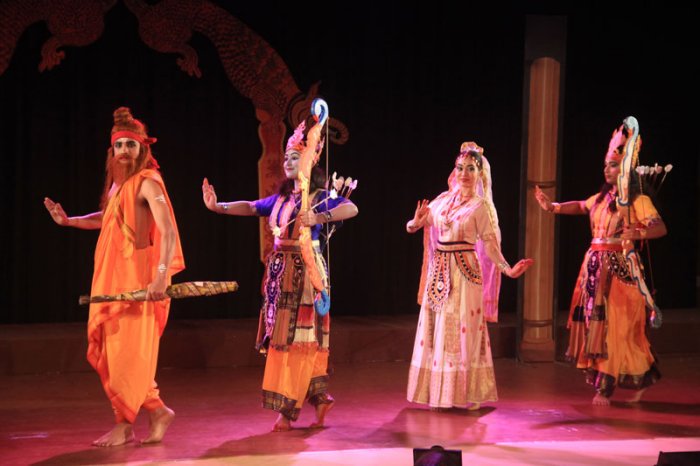
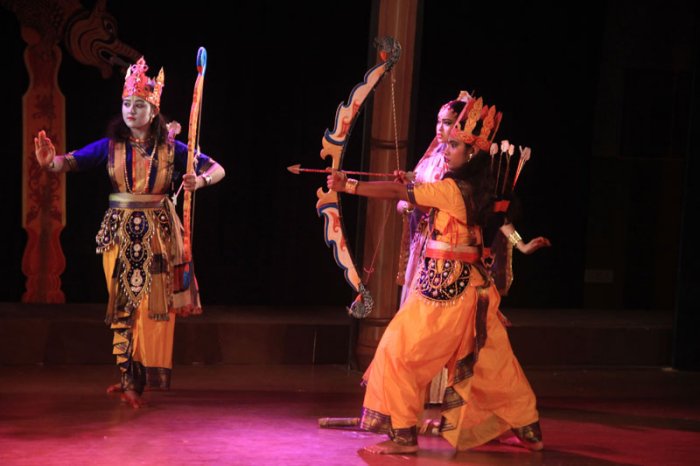
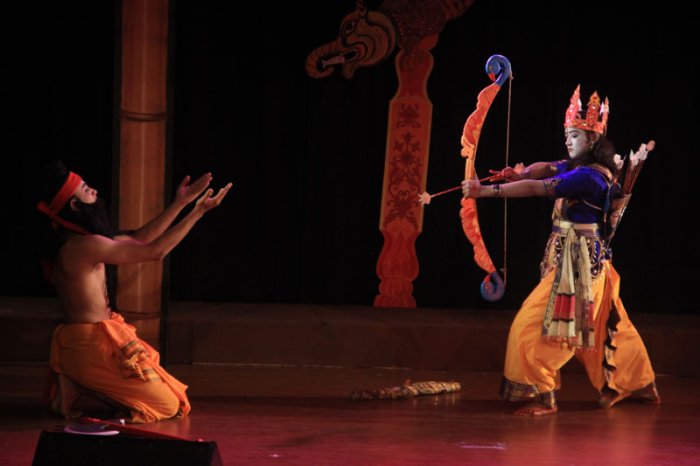
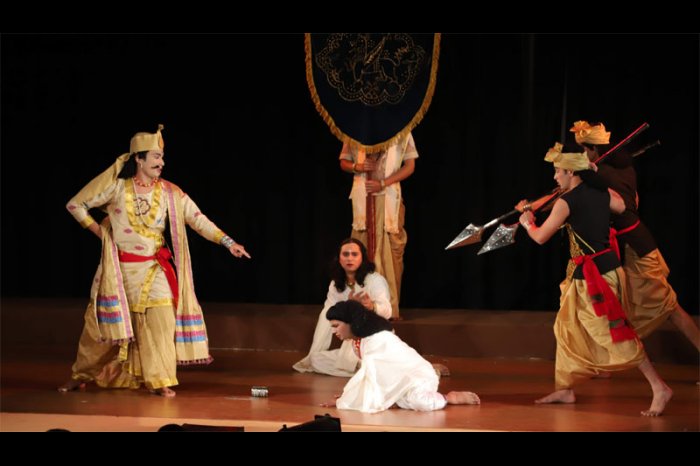
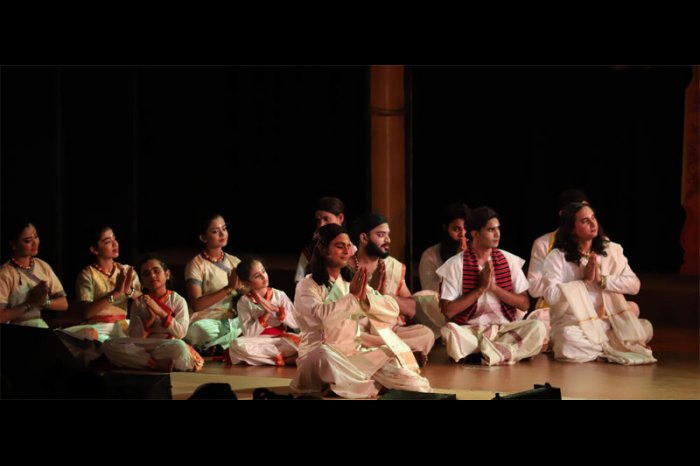
At a young age Sankaradeva was a frequent traveller going by boat to several places of pilgrimage constantly listening to Bhajans sung to the gods. He hears the Gita Govinda ashtapadi “Rase Harimiha Vihita vilasam” as a kind of Mahari dance sung and enacted in a group. His visit to Puri to the Jagannath temple was a momentous event. While Sankaradeva was a Krishna Bhakta, his philosophy, it is important to remember, did not acknowledge Radha as an entity. While nearby Manipur made Radha the centre of its Ras Lila, Sattriya, peculiarly, has no Radha reference in its repertoire of dance and music. Sankaradeva listens to the Dohas of Kabir and much else and it is believed that he was a great admirer of Kabir and while his own faith was Vaishnavism, his teachings followed the simplicity of the ways of worship of Kabir and Guru Nanak - both of them being nonbelievers in ritualism - as Sankaradeva too was. It was in fact this simplicity with Kirtana (chanting) and Sravana (hearing) rated above Pathana (reading) that drew the common people to him. Inspired by Bhajans and chantings near the temples he visited, Sankaradeva is seen in ecstasy. The narrative shifts from Bardowa to his stay at Majuli where Sankaradeva's life took on new dimensions with his first meeting with Madhavadeva who was a devout Sakta, whom he converted and won over to his religious convictions through several interactions. That scene with the arrogant orange clad Brahmins, and a conceited Madhavadeva who finally falls at his feet accepting him as Guru, after listening to Sankaradeva's chantings of Srimad Bhagavat Purana verses Yatha tarurmula nihsecanena trpyanti Tatskhandha bhujopasakhak Prapnopaharcca yathendriyanam tathaiva Sarvahanamocyuteja (As branches, leaves of a tree are nourished by watering its roots, as the body limbs are nurtured by feeding the stomach, so are all Gods and Goddesses propitiated when Achyuta is worshipped). The scene shifts to the Ahom King ruling over this area whose relationship with the Bhuyas (a feudal title given to a predominantly Kayastha self-governing group Sankaradeva belonged to) changed, due to constant complaints from the jealous Brahmin priests against Sankaradeva and his followers as heretics, and Sankaradeva's son-in-law earlier appointed by the King, was executed, with a grief stricken religious teacher forced to leave this area - all captured in brief but telling glimpses. Sankaradeva finally reaches Patbausi ruled by the Kosa dynasty with ruler Naranarayana becoming a close disciple of his and Sankaradeva remains here for the last 18 years of his 120 year old life. Glimpses of Sattra training are visualised with kids being put through their paces learning the Mati akhada exercises preparing the body of the child monks for the rigor of the Sattriya training to follow. Young dancers both male and female, elegantly turned out, perform dances like Chali Dance and one sees something like the Sutradhar dance with the typical special turban with a conical tip at the back. There are glimpses of Sattriya drama with a short scene of the Parashurama/Rama encounter. The exquisitely tasteful costumes by Minakhee Gogoi with Kiran Borah, Govinda Kalita and Rajib Kakoti need special mention. The cymbal performance and the Tarana like group rendition bring down the curtain. The sound tape was contributed by several singers who rendered Borgeet compositions and other songs with great devotional fervour though not always in perfect sur. The instrumental interventions and percussion parts were superb. On the occasion the Boloram Bargayan award 2018 for contribution to Sattriya music was conferred on Punyabrata Dev Goswami. The entire endeavour (Oct 27, 2018 at JNU Convention Centre, Delhi), supported by financial help from the Ministry of Culture, and companies like ONGC and NRL was meticulously planned and presented.  Writing on the dance scene for the last forty years, Leela Venkataraman's incisive comments on performances of all dance forms, participation in dance discussions both in India and abroad, and as a regular contributor to Hindu Friday Review, journals like Sruti and Nartanam, makes her voice respected for its balanced critiquing. She is the author of several books like Indian Classical dance: Tradition in Transition, Classical Dance in India and Indian Classical dance: The Renaissance and Beyond. Post your comments Please provide your name and email id when you use the Anonymous profile in the blog to post a comment. All appropriate comments posted with name & email id in the blog will also be featured in the site. |